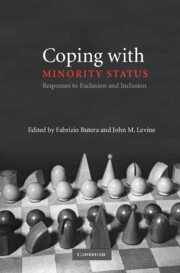Book contents
- Frontmatter
- Contents
- Contributors
- Introduction
- PART I COPING WITH EXCLUSION: BEING EXCLUDED FOR WHO YOU ARE
- PART 2 COPING WITH EXCLUSION: BEING EXCLUDED FOR WHAT YOU THINK AND DO
- 6 Delinquents as a minority group: Accidental tourists in forbidden territory or voluntary emigrées?
- 7 Minority-group identification: Responses to discrimination when group membership is controllable
- 8 Coping with stigmatization: Smokers' reactions to antismoking campaigns
- 9 Terrorism as a tactic of minority influence
- 10 The stigma of racist activism
- 11 Why groups fall apart: A social psychological model of the schismatic process
- PART 3 COPING WITH INCLUSION
- Index
- References
9 - Terrorism as a tactic of minority influence
Published online by Cambridge University Press: 05 June 2012
- Frontmatter
- Contents
- Contributors
- Introduction
- PART I COPING WITH EXCLUSION: BEING EXCLUDED FOR WHO YOU ARE
- PART 2 COPING WITH EXCLUSION: BEING EXCLUDED FOR WHAT YOU THINK AND DO
- 6 Delinquents as a minority group: Accidental tourists in forbidden territory or voluntary emigrées?
- 7 Minority-group identification: Responses to discrimination when group membership is controllable
- 8 Coping with stigmatization: Smokers' reactions to antismoking campaigns
- 9 Terrorism as a tactic of minority influence
- 10 The stigma of racist activism
- 11 Why groups fall apart: A social psychological model of the schismatic process
- PART 3 COPING WITH INCLUSION
- Index
- References
Summary
Since the late 1970s, the topic of minority influence has constituted an important research issue for social psychologists. Introduced by Serge Moscovici's seminal papers (Moscovici, 1980, 1985), minority influence research exemplified minority influence in that it innovated and deviated from the tendency to view social influence phenomena predominantly from the majority's perspective.
As Moscovici aptly noted, majority influence serves to preserve existing knowledge (by which we mean widely received views or shared realities) whereas new knowledge, germinating as it typically does in the mind of one person or in the discussions of a small group of people, presupposes the influence of a minority on a dominant majority. The typical metaphor for much minority influence research was nonviolent influence by the minority through socially sanctioned means, such as debates, publications, media appearances, lawful protests, and licensed public demonstrations. The prototypical cases of minority influence phenomena were innovations in science and technology, minority-prompted change in political attitudes, and shifts in the world of fashion, and so on.
But in the past several decades, a very different type of influence tactic has captivated the world's attention and mobilized the resources of nations; it goes by the name of “terrorism” and is considered by many the scourge of our times. Many different definitions of terrorism have been proposed over the years (Schmid & Jongman, 1988).
- Type
- Chapter
- Information
- Coping with Minority StatusResponses to Exclusion and Inclusion, pp. 202 - 221Publisher: Cambridge University PressPrint publication year: 2009
References
- 3
- Cited by

